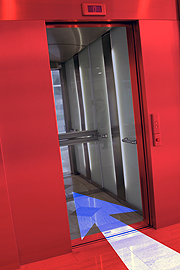
Common wisdom dictates that we do not take lifts (elevators) when evacuating buildings. However, a new ISO technical report reveals that lifts may be viable escape options, and provides a decision chart to help identify risks. These findings may save the lives of people who have difficulties using stairs, such as the disabled, the elderly, or pregnant women and small children.
“Over the past few years there has been considerable debate regarding the risks and hazards associated with using lifts during evacuations,” says Derek Smith, Project Leader of the report (ISO/TR 25743).
“As buildings get taller and larger, determining the extent of these risks and what can be done to minimize them, is even more pressing. Particularly as lifts can help persons with restricted mobility and other problems to evacuate buildings with relative ease. And in some special cases, depending on the building’s size and design, lifts may also significantly reduce general evacuation time,” explains Mr. Smith.
The report, ISO/TR 25743:2010, Lifts (elevators) – Study of the use of lifts for evacuation during an emergency, investigates and highlights the main risks associated with using lifts to evacuate persons in various types of emergencies: fires, explosions, chemical or biological attacks, flooding, lighting or storm damage, earthquakes and gas leakage.
ISO/TR 25743 was produced in collaboration with lift and other specialists. Its key objective is to provide building designers with a decision-making process to determine whether a given design can enable the safe use of lifts in the event of an emergency for a particular building. The report can be applied to lifts and buildings of any size, whether new or existing.
For this purpose, ISO/TR 25743 includes an innovative easy-to-read chart which guides users through a yes/no decision-making process asking questions such as:
- Is the emergency a fire?
- Should the building be evacuated?
- Has the structure been compromised?
Each answer leads to another question, or to an informed decision. Detailed explanations are given in an annex.
The recommendations in the report will be useful to persons involved in building design and fire engineering. “The report provides guidance,” explains Mr. Smith, “but clearly the final decision will be taken by the building designer. Not all buildings are subject to the same risks and it is up to the designer to identify the most important risks for each structure and select the most appropriate solutions.”
ISO/TR 25743:2010, Lifts (elevators) – Study of the use of lifts for evacuation during an emergency, was developed by ISO technical committee ISO/TC 178, Lifts, escalators and moving walks, and is available from ISO national member institutes (see the complete list with contact details). It may also be obtained directly from the ISO Central Secretariat, price 124 Swiss francs, through the ISO Store or by contacting the Marketing, Communication and Information department (see right-hand column).
